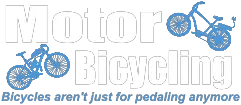What happened here? The tire started going out of true, started warping. I took it off, removed the rear drive assembly and BAM! It looks chewed up, like 6-8 spokes brokes off (about an inch up-right where the everything mounts). This wheel is finished and I've since mounted a "double-wall" wheel to my MB to help.
I didn't especially tighten the rear sprocket that often - is that it? What can I do to prevent this in the future?

I didn't especially tighten the rear sprocket that often - is that it? What can I do to prevent this in the future?





